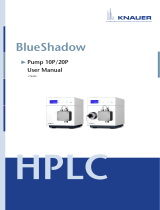
Annex Anhang
V6901 · 2012-01-13
Handling of PEEK fittings
PEEK is an organic solvent-resistant polymer which is resistant against
high temperatures and high pressures. These advantages make PEEK
the material of choice for fittings. But, PEEK fittings can be shorn off
more easily than stainless steel, if too much torque is applied. On the
other hand, a PEEK fitting will not seal a connection correctly, if insuffi-
cient torque is used. Therefore, PEEK fittings must be handled with
care in order to seal a capillary connection tightly.
We recommend you use a ¼'' wrench to tighten the hex-head PEEK fit-
tings listed below. Do not apply more than 0.5 Nm torque, other-
wise the head of the fitting may deform and shear off. With the tubing
held in place, finger-tighten the fitting completely and then wrench-
tighten it another ¾ turn. If the fitting is still not swaged to the tubing
or if the connection is leaky, remove the fitting and check the capillary
is correctly positioned on the fitting. Do not overtighten the fitting
more than one whole turn after finger-tightening.
4 different kinds of PEEK fittings can be used with your system,
depending on your configuration.
Note Please refer to the table below to identify the correct fitting. Fittings
can be distinguished by the marking on the head.
Attention! Please be aware that P3860V2 and P3860V3 must be used to connect
the PDA-1 flow cell. Using other fittings will destroy the flow cell and/
or will lead to a leakage.
Please keep in mind that all PEEK fittings are single-use consumables. If
a fitting is screwed into a column (for example), the cone of the fitting
will be swaged to seal this connection perfectly tight. Afterwards, the
fitting can only be used with this column exclusively. It can be
removed and reinstalled several times, but it can not be used with a
different device.
Figure 1 Type Explanations
P3860 with short head and
tip
P3860 and P3860V1 can be used to
connect capillaries to KNAUER
columns
P3860V1 with long head
and tip
P3860 and P3860V1 can be used to
connect capillaries to KNAUER
columns
P3860V2 with long head
and without tip. This screw
fitting is marked by one
notch 1
P3860V2 is to be used for the outlet
of your PDA-1 flow cell.
P3860V3 with long head
and short tip. This screw
fitting is marked by two
notches 2
P3860V3 is to be used for the inlet of
your PDA-1 flow cell. P3860V3 is also
compatible to Upchurch® scientific
standard ports.
1
2

Annex Anhang
V6901 · 2012-01-13
Handhabung von PEEK-Verschraubungen
PEEK ist ein organisches, lösungsmittelbeständiges Polymer, das hohen
Temperaturen und hohen Drücken standhält. Diese Vorteile machen
PEEK zu einem idealen Material für Schraubverbindungen. PEEK-Ver-
schraubungen können leichter abreißen als Edelstahlverschraubungen,
falls sie zu stark angezogen werden. Werden sie nicht stark genug
angezogen, dichten PEEK-Verschraubungen nicht korrekt ab. Um eine
dichte Kapillarverbindung herzustellen, müssen PEEKVer-
schraubungen deshalb vorsichtig behandelt werden.
Zum Festziehen der unten aufgeführten Sechskant-PEEK-Ver-
schraubungen empfehlen wir einen ¼''-Maulschlüssel.
Das Drehmoment
darf 0,5 Nm nicht überschreiten.
Ein höheres Moment könnte den Kopf
der Verschraubung verformen oder abreißen. Das Schlauchmaterial fixie-
ren und die Schraubverbindung fingerfest anziehen. Die Verschraubung
anschließend mit dem Schlüssel um eine weitere Dreiviertelumdrehung
festziehen. Falls die Schraubverbindung nicht fest mit der Leitung verbun-
den oder falls sie undicht ist, die Schraubverbindung entfernen und
sicherstellen, dass das Kapillarrohr korrekt auf der Schraubverbindung
positioniert ist. Die Schraubverbindung nicht zu stark anziehen.
Nach dem fingerfesten Anziehen maximal eine zusätzliche Umdrehung
anwenden. Für Ihr System können je nach Konfiguration vier ver-
schiedene PEEK-Verschraubungen verwendet werden.
Hinweis
Verwenden Sie die unten aufgeführte Tabelle, um die korrekte Schraub-
verbindung zu ermitteln. Zur Unterscheidung sind die Schraubver-
bindungen auf dem Kopf mit einer Markierung gekennzeichnet
.
Achtung! Bitte beachten Sie, dass für den Anschluss der PDA-1 Messzelle
unbedingt P3860V2 und P3860V3 verwendet werden müssen. Die
Verwendung anderer Schraubverbindungen führt zur Zerstörung der
Messzelle und/oder zu Lecks.
Alle PEEK-Verschraubungen sind Einwegteile. Wird eine Schraubver-
bindung in eine Säule geschraubt, wird der Kegel gequetscht, um die
Verbindung abzudichten. Die Schraubverbindung kann später aus-
schließlich auf dieser Säule verwendet werden. Sie kann mehrmals ent-
fernt und wieder angebracht, jedoch nicht mit anderen Geräten
verwendet werden.
Abbildung 1 Typ Erläuterungen
P3860 mit Kurzkopf
und Spitze
P3860 und P3860V1 können zum
Anschluss von Kapillaren an
KNAUER Säulen verwendet werden
P3860V1 mit Langkopf und
Spitze
P3860 und P3860V1 können zum
Anschluss von Kapillaren an
KNAUER Säulen verwendet werden
P3860V2 mit Langkopf, ohne
Spitze. Diese Schraubver-
bindung ist durch eine
Einkerbung 1 gekennzeichnet
P3860V2 wird für den Auslass Ihrer
PDA-1 Messzelle verwendet.
P3860V3 mit Langkopf
und kurzer Spitze.
Diese Schraubverbindung ist
durch zwei Einkerbungen 2
gekennzeichnet
P3860V3 wird für den Einlass Ihrer
PDA-1 Messzelle verwendet.
P3860V3 ist zudem kompatibel mit
Upchurch® Scientific Standard-
anschlüssen.
1
2
/









